Shenzhou 7
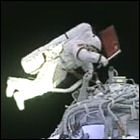 China launches its third crewed space mission, Shenzhou 7, into Earth orbit. For the first time, a full complement of three taikonauts is aboard (Zhai Zhigang, Liu Boming, and Jing Haipeng), and in another Chinese space first, Zhigang and Boming exit the spacecraft for a 22-minute spacewalk. Also during this flight, Shenzhou 7 passes within 30 miles of the International Space Station, posing no hazard but raising security concerns from the United States government. Because the customary solar panels of the Shenzhou spacecraft have not been installed to allow for the spacewalk (and unobstructed television coverage of the spacewalk), the mission lasts only three days.
China launches its third crewed space mission, Shenzhou 7, into Earth orbit. For the first time, a full complement of three taikonauts is aboard (Zhai Zhigang, Liu Boming, and Jing Haipeng), and in another Chinese space first, Zhigang and Boming exit the spacecraft for a 22-minute spacewalk. Also during this flight, Shenzhou 7 passes within 30 miles of the International Space Station, posing no hazard but raising security concerns from the United States government. Because the customary solar panels of the Shenzhou spacecraft have not been installed to allow for the spacewalk (and unobstructed television coverage of the spacewalk), the mission lasts only three days.
STS-124
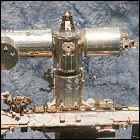 Space Shuttle Discovery is launched on the 123rd shuttle flight, a two-week mission to install a major laboratory module to the International Space Station. The pressurized module of Japan’s Kibo laboratory joins the unpressurized section installed on a previous flight, complete with its own robotic arm controlled inside. Aboard Discovery for her 35th flight are Commander Mark Kelly, Pilot Ken Ham, mission specialists Karen Nyberg, Ron Garan and Mike Fossum, and Japanese astronaut Akihiko Hoshide, who remains on the International Space Station. Station astronaut Garrett Reisman returns to Earth aboard Discovery.
Space Shuttle Discovery is launched on the 123rd shuttle flight, a two-week mission to install a major laboratory module to the International Space Station. The pressurized module of Japan’s Kibo laboratory joins the unpressurized section installed on a previous flight, complete with its own robotic arm controlled inside. Aboard Discovery for her 35th flight are Commander Mark Kelly, Pilot Ken Ham, mission specialists Karen Nyberg, Ron Garan and Mike Fossum, and Japanese astronaut Akihiko Hoshide, who remains on the International Space Station. Station astronaut Garrett Reisman returns to Earth aboard Discovery.
Soyuz TMA-12 / ISS Expedition 17
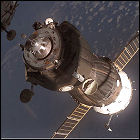 The seventeenth full-time crew of the International Space Station lifts off from Russia’s Baikonur Cosmodrome aboard Soyuz TMA-12. Sergei Volkov and Oleg Kononenko take up residence on the ISS for 199 days. Arriving with them on the ISS for a ten-day stay is South Korean astronaut Yi So-Yeon, who returns to Earth aboard Soyuz TMA-11 with the Expedition 16 crew.
The seventeenth full-time crew of the International Space Station lifts off from Russia’s Baikonur Cosmodrome aboard Soyuz TMA-12. Sergei Volkov and Oleg Kononenko take up residence on the ISS for 199 days. Arriving with them on the ISS for a ten-day stay is South Korean astronaut Yi So-Yeon, who returns to Earth aboard Soyuz TMA-11 with the Expedition 16 crew.
STS-123
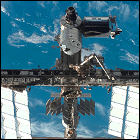 Space Shuttle Endeavour lifts off on the 122nd shuttle flight, a 16 day mission to deliver two new key components of the International Space Station. The unpressurized portion of the Japanese Aerospace Exploration Agency’s Kibo laboratory is delivered and attached, while the two-armed Dextre robotic arm system built in Canada is also installed. Aboard Endeavour for her 21st flight are Commander Dominic Gorie, Pilot Greg Johnson, and mission specialists Garrett Reisman, Robert Behnken, Mike Foreman, Takao Doi and Rick Linnehan. Reisman remains on the ISS, while station astronaut Leopold Eyharts hitches a ride back to Earth aboard the shuttle.
Space Shuttle Endeavour lifts off on the 122nd shuttle flight, a 16 day mission to deliver two new key components of the International Space Station. The unpressurized portion of the Japanese Aerospace Exploration Agency’s Kibo laboratory is delivered and attached, while the two-armed Dextre robotic arm system built in Canada is also installed. Aboard Endeavour for her 21st flight are Commander Dominic Gorie, Pilot Greg Johnson, and mission specialists Garrett Reisman, Robert Behnken, Mike Foreman, Takao Doi and Rick Linnehan. Reisman remains on the ISS, while station astronaut Leopold Eyharts hitches a ride back to Earth aboard the shuttle.
STS-122
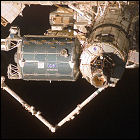 Space Shuttle Atlantis lifts off on the 121st shuttle flight, a 13-day mission to deliver another laboratory module to the International Space Station. The European Space Agency’s Columbus lab module is ESA’s contribution to the station, and is attached to the recently-installed Harmony node over the course of three spacewalks. Aboard Atlantis for her 29th flight are Commander Steve Frick, Pilot Alan Poindexter, and mission specialists Stanley Love, Leland Melvin, Rex Walheim and Hans Schlegel. ISS Expedition 17 crewmember Leopold Eyharts travels to the station aboard Atlantis, while ISS Expedition 16 crewmember Daniel Tani returns to Earth on the shuttle in his place.
Space Shuttle Atlantis lifts off on the 121st shuttle flight, a 13-day mission to deliver another laboratory module to the International Space Station. The European Space Agency’s Columbus lab module is ESA’s contribution to the station, and is attached to the recently-installed Harmony node over the course of three spacewalks. Aboard Atlantis for her 29th flight are Commander Steve Frick, Pilot Alan Poindexter, and mission specialists Stanley Love, Leland Melvin, Rex Walheim and Hans Schlegel. ISS Expedition 17 crewmember Leopold Eyharts travels to the station aboard Atlantis, while ISS Expedition 16 crewmember Daniel Tani returns to Earth on the shuttle in his place.
STS-120
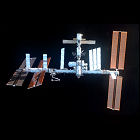 Space Shuttle Discovery lifts off on the 120th shuttle flight, a 15-day mission to deliver a new module to the International Space Station. The module in question is the Harmony node, which adds space for further modules to be added by future shuttle missions. Aboard Discovery for her 34th mission are Commander Pamela Melroy, Pilot George Zamka, mission specialists Douglas Wheelock, Scott Parazynski, Stephanie Wilson and Paolo Nespoli, and ISS Expedition 16 crewmember Daniel Tani, who remains on the station. Among the items stowed away aboard the shuttle are the screen-used lightsaber prop wielded by Luke Skywalker in Return Of The Jedi.
Space Shuttle Discovery lifts off on the 120th shuttle flight, a 15-day mission to deliver a new module to the International Space Station. The module in question is the Harmony node, which adds space for further modules to be added by future shuttle missions. Aboard Discovery for her 34th mission are Commander Pamela Melroy, Pilot George Zamka, mission specialists Douglas Wheelock, Scott Parazynski, Stephanie Wilson and Paolo Nespoli, and ISS Expedition 16 crewmember Daniel Tani, who remains on the station. Among the items stowed away aboard the shuttle are the screen-used lightsaber prop wielded by Luke Skywalker in Return Of The Jedi.
Soyuz TMA-11 / ISS Expedition 16
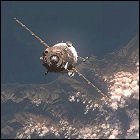 The sixteenth full-time crew of the International Space Station lifts off from Russia’s Baikonur Cosmodrome aboard Soyuz TMA-11. Yuri Malenchenko and Peggy Whitson take up residence on the ISS for 196 days. Arriving with them on the ISS for a ten-day stay is Malaysian space tourist Sheikh Muszaphar Shukor, who returns to Earth aboard Soyuz TMA-10 with the Expedition 15 crew. Like other “space tourists” before him, he has paid for his own Soyuz seat and mission training. When Malenchenko and Whitson return in April 2008 with South Korean astronaut Yi So-Yeon, the Soyuz suffers a dangerous malfunction, failing to jettison its service module; the result is an off-balance spacecraft that re-enters the atmosphere nose-first, exposing under-insulated portions of the vehicle to the heat of re-entry and forcing the crew to endure 10 Gs. The vehicle lands nearly 300 miles off-course and Yi So-Yeon suffers neck and spinal injuries in the landing; the head of the Russian space program doesn’t improve matters by blaming these events on an “old Russian superstition” that having more women than men in a vehicle is bad luck. NASA and Russian space engineers begin investigating the mishap, finally arriving at the more plausible explanation of a malfunctioning spacecraft.
The sixteenth full-time crew of the International Space Station lifts off from Russia’s Baikonur Cosmodrome aboard Soyuz TMA-11. Yuri Malenchenko and Peggy Whitson take up residence on the ISS for 196 days. Arriving with them on the ISS for a ten-day stay is Malaysian space tourist Sheikh Muszaphar Shukor, who returns to Earth aboard Soyuz TMA-10 with the Expedition 15 crew. Like other “space tourists” before him, he has paid for his own Soyuz seat and mission training. When Malenchenko and Whitson return in April 2008 with South Korean astronaut Yi So-Yeon, the Soyuz suffers a dangerous malfunction, failing to jettison its service module; the result is an off-balance spacecraft that re-enters the atmosphere nose-first, exposing under-insulated portions of the vehicle to the heat of re-entry and forcing the crew to endure 10 Gs. The vehicle lands nearly 300 miles off-course and Yi So-Yeon suffers neck and spinal injuries in the landing; the head of the Russian space program doesn’t improve matters by blaming these events on an “old Russian superstition” that having more women than men in a vehicle is bad luck. NASA and Russian space engineers begin investigating the mishap, finally arriving at the more plausible explanation of a malfunctioning spacecraft.
STS-118 puts a teacher in space
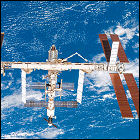 Space Shuttle Endeavour lifts off on the 119th shuttle flight, a 12-day mission to the International Space Station. Additional truss sections are delivered and installed at the station to support solar power arrays, along with the delivery of 5,000 pounds of supplies, consumables and experiments. Aboard Endeavour for her 20th flight are Commander Scott Kelly, Pilot Charles Hobaugh, and mission specialists Richard Mastracchio, Dr. Dafydd Williams, Barbara Morgan, Dr. Tracy Caldwell and Benjamin Drew. Morgan is the first Teacher In Space, having been Christa McAuliffe’s backup in the 1980s, finally fulfilling the Teacher In Space program after 21 years.
Space Shuttle Endeavour lifts off on the 119th shuttle flight, a 12-day mission to the International Space Station. Additional truss sections are delivered and installed at the station to support solar power arrays, along with the delivery of 5,000 pounds of supplies, consumables and experiments. Aboard Endeavour for her 20th flight are Commander Scott Kelly, Pilot Charles Hobaugh, and mission specialists Richard Mastracchio, Dr. Dafydd Williams, Barbara Morgan, Dr. Tracy Caldwell and Benjamin Drew. Morgan is the first Teacher In Space, having been Christa McAuliffe’s backup in the 1980s, finally fulfilling the Teacher In Space program after 21 years.
STS-117
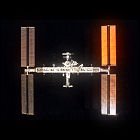 Space Shuttle Atlantis lifts off the 118th shuttle flight, on a two-week mission to resupply and continue assembly of the International Space Station. Two major structural trusses and two large solar power arrays are delivered and installed, and a damaged array is removed. Aboard Atlantis for her 28th flight are Commander Rick Sturckow, Pilot Lee Archambault, and mission specialists Patrick Forrester, Danny Olivas, Clayton Anderson, Jim Reilly and Steven Swanson. Anderson remains on the station, joining the crew of ISS Expedition 15.
Space Shuttle Atlantis lifts off the 118th shuttle flight, on a two-week mission to resupply and continue assembly of the International Space Station. Two major structural trusses and two large solar power arrays are delivered and installed, and a damaged array is removed. Aboard Atlantis for her 28th flight are Commander Rick Sturckow, Pilot Lee Archambault, and mission specialists Patrick Forrester, Danny Olivas, Clayton Anderson, Jim Reilly and Steven Swanson. Anderson remains on the station, joining the crew of ISS Expedition 15.
Wally Schirra, Mercury astronaut, dies
 Astronaut Wally Schirra, one of the seven original Mercury astronauts, and the only astronaut to lift off aboard Mercury, Gemini and Apollo missions, dies at the age of 84. Selected as one of the first “class” of American astronauts, Schirra was the fifth American to fly in space, making six orbits of the Earth in 1962. He commanded Gemini 6, and was the commander of Apollo 7, the first manned Apollo mission, which tested the capabilities of the redesigned Apollo command/service module in Earth orbit. In 1969, he retired from NASA and immediately landed a new gig, sitting aside TV news legend Walter Cronkite for coverage of the missions to the moon, as well as continuing to offer insider commentary on space coverage at CBS through 1975. He was awarded numerous medals by both NASA and the United States Navy, among countless other honors.
Astronaut Wally Schirra, one of the seven original Mercury astronauts, and the only astronaut to lift off aboard Mercury, Gemini and Apollo missions, dies at the age of 84. Selected as one of the first “class” of American astronauts, Schirra was the fifth American to fly in space, making six orbits of the Earth in 1962. He commanded Gemini 6, and was the commander of Apollo 7, the first manned Apollo mission, which tested the capabilities of the redesigned Apollo command/service module in Earth orbit. In 1969, he retired from NASA and immediately landed a new gig, sitting aside TV news legend Walter Cronkite for coverage of the missions to the moon, as well as continuing to offer insider commentary on space coverage at CBS through 1975. He was awarded numerous medals by both NASA and the United States Navy, among countless other honors.
Soyuz TMA-10 / ISS Expedition 15
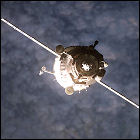 The fifteenth full-time crew of the International Space Station lifts off from Russia’s Baikonur Cosmodrome aboard Soyuz TMA-10. Oleg Kotov and Fyodor Yurchikhin take up residence on the ISS for 196 days. Arriving with them on the ISS for an 11-day stay is space tourist Charles Simonyi, a Microsoft software engineer (whose successes included such widely-used software as Microsoft Word and Excel), who returns to Earth aboard Soyuz TMA-9 with the Expedition 14 crew. Like other “space tourists” before him, he has paid for his own Soyuz seat and mission training. When Kotov and Yurchikhin return in October 2007, the Soyuz suffers a dangerous malfunction, failing to jettison its service module; the result is an off-balance spacecraft that re-enters the atmosphere nose-first, exposing under-insulated portions of the vehicle to the heat of re-entry. The crew manages a survivable landing, but news of the incident is kept quiet by the Russian space program until a similar mishap occurs aboard the next Soyuz flight.
The fifteenth full-time crew of the International Space Station lifts off from Russia’s Baikonur Cosmodrome aboard Soyuz TMA-10. Oleg Kotov and Fyodor Yurchikhin take up residence on the ISS for 196 days. Arriving with them on the ISS for an 11-day stay is space tourist Charles Simonyi, a Microsoft software engineer (whose successes included such widely-used software as Microsoft Word and Excel), who returns to Earth aboard Soyuz TMA-9 with the Expedition 14 crew. Like other “space tourists” before him, he has paid for his own Soyuz seat and mission training. When Kotov and Yurchikhin return in October 2007, the Soyuz suffers a dangerous malfunction, failing to jettison its service module; the result is an off-balance spacecraft that re-enters the atmosphere nose-first, exposing under-insulated portions of the vehicle to the heat of re-entry. The crew manages a survivable landing, but news of the incident is kept quiet by the Russian space program until a similar mishap occurs aboard the next Soyuz flight.
STS-116
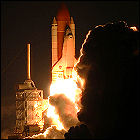 Space Shuttle Discovery returns to the International Space Station to add another major structural truss, resupply the station, and swap crew members. During this flight, the 75th spacewalk involving station construction takes place, moving part of the station’s solar power apparatus to another part of the station. Aboard Discovery for this flight are Commander Mark Polansky, Pilot William Oefelein, and mission specialists Robert Curbeam, Joan Higginbotham, Nicholas Patrick, Christer Fuglesang and Sunita Williams, who will stay on the International Space Station as its new flight engineer. Returning with Discovery is Thomas Reiter, who was flown to the station aboard Discovery in July.
Space Shuttle Discovery returns to the International Space Station to add another major structural truss, resupply the station, and swap crew members. During this flight, the 75th spacewalk involving station construction takes place, moving part of the station’s solar power apparatus to another part of the station. Aboard Discovery for this flight are Commander Mark Polansky, Pilot William Oefelein, and mission specialists Robert Curbeam, Joan Higginbotham, Nicholas Patrick, Christer Fuglesang and Sunita Williams, who will stay on the International Space Station as its new flight engineer. Returning with Discovery is Thomas Reiter, who was flown to the station aboard Discovery in July.
Soyuz TMA-9 / Expedition 14
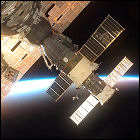 The fourteenth full-time crew of the International Space Station lifts off from Russia’s Baikonur Cosmodrome aboard Soyuz TMA-9. Mikhail Tyurin and Michael López-Alegría take up residence on the ISS for 215 days; with the American space shuttle fleet back in action, longer ISS stays with larger crews are once again possible.. Arriving with them on the ISS for a nine-day stay is Iranian-born telecommunications entrepreneur (and Ansari X-Prize founder) Anousheh Ansari, who returns to Earth aboard Soyuz TMA-8 with the Expedition 13 crew. Like other “space tourists” before her, she has paid for her own Soyuz seat and mission training.
The fourteenth full-time crew of the International Space Station lifts off from Russia’s Baikonur Cosmodrome aboard Soyuz TMA-9. Mikhail Tyurin and Michael López-Alegría take up residence on the ISS for 215 days; with the American space shuttle fleet back in action, longer ISS stays with larger crews are once again possible.. Arriving with them on the ISS for a nine-day stay is Iranian-born telecommunications entrepreneur (and Ansari X-Prize founder) Anousheh Ansari, who returns to Earth aboard Soyuz TMA-8 with the Expedition 13 crew. Like other “space tourists” before her, she has paid for her own Soyuz seat and mission training.
STS-115
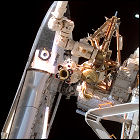 Space Shuttle Atlantis lifts off for its first spaceflight, and the first normal International Space Station construction mission, in four years. A new truss section with more 240-foot solar power panels is added to the station over the course of three spacewalks, each lasting at least six hours. Aboard Atlantis for this flight are Commander Brent Jett, Pilot Christopher Ferguson, and mission specialists Heidemarie Stefanyshyn-Piper, Joe Tanner, Daniel Burbank, and Steven MacLean.
Space Shuttle Atlantis lifts off for its first spaceflight, and the first normal International Space Station construction mission, in four years. A new truss section with more 240-foot solar power panels is added to the station over the course of three spacewalks, each lasting at least six hours. Aboard Atlantis for this flight are Commander Brent Jett, Pilot Christopher Ferguson, and mission specialists Heidemarie Stefanyshyn-Piper, Joe Tanner, Daniel Burbank, and Steven MacLean.
NASA, SpaceX sign cargo launch agreement
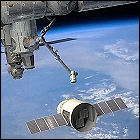 Impressed with the progress shown by the commercial spaceflight industry, NASA signs agreements with SpaceX, a venture started by PayPal founder Elon Musk, and Oklahoma-based Rocketplane Kistler (RPK) to begin developing spacecraft that can deliver cargo and, later, astronauts to the International Space Station. RPK’s bid eventually collapses in financial scandal, though SpaceX goes on to create Dragon, the first privately-funded vehicle to visit the ISS in 2012.
Impressed with the progress shown by the commercial spaceflight industry, NASA signs agreements with SpaceX, a venture started by PayPal founder Elon Musk, and Oklahoma-based Rocketplane Kistler (RPK) to begin developing spacecraft that can deliver cargo and, later, astronauts to the International Space Station. RPK’s bid eventually collapses in financial scandal, though SpaceX goes on to create Dragon, the first privately-funded vehicle to visit the ISS in 2012.
STS-121
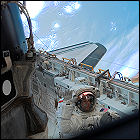 NASA launches Space Shuttle Discovery for the first time in nearly a year for a second “Return to Flight” mission to the International Space Station, testing more safety procedures and new materials developed since the July 2005 flight (which still required repairs to be conducted in orbit). Aboard Discovery are Commander Steven Lindsey, Pilot Mark Kelly, and mission specialists Stephanie Wilson, Michael Fossum, Piers Sellers, Thomas Reiter and Lisa Nowak. Reiter remains aboard the station, bumping its crew up to three people for the first time since 2003.
NASA launches Space Shuttle Discovery for the first time in nearly a year for a second “Return to Flight” mission to the International Space Station, testing more safety procedures and new materials developed since the July 2005 flight (which still required repairs to be conducted in orbit). Aboard Discovery are Commander Steven Lindsey, Pilot Mark Kelly, and mission specialists Stephanie Wilson, Michael Fossum, Piers Sellers, Thomas Reiter and Lisa Nowak. Reiter remains aboard the station, bumping its crew up to three people for the first time since 2003.
Soyuz TMA-8 / ISS Expedition 13
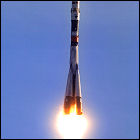 The thirteenth full-time crew of the International Space Station lifts off from Russia’s Baikonur Cosmodrome aboard Soyuz TMA-8. Pavel Vinogradov and Jeffrey Williams take up residence on the ISS for 182 days; during their stay, the ISS crew expands to three with the arrival of Thomas Reiter aboard space shuttle Discovery, marking the remaining shuttle fleet’s temporary return to service. Arriving with them on the ISS for a nine-day stay is Brazilian astronaut Marcos Pontes, who returns to Earth aboard Soyuz TMA-7 with the Expedition 12 crew.
The thirteenth full-time crew of the International Space Station lifts off from Russia’s Baikonur Cosmodrome aboard Soyuz TMA-8. Pavel Vinogradov and Jeffrey Williams take up residence on the ISS for 182 days; during their stay, the ISS crew expands to three with the arrival of Thomas Reiter aboard space shuttle Discovery, marking the remaining shuttle fleet’s temporary return to service. Arriving with them on the ISS for a nine-day stay is Brazilian astronaut Marcos Pontes, who returns to Earth aboard Soyuz TMA-7 with the Expedition 12 crew.
Shenzhou 6
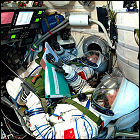 China returns to Earth orbit with the launch of Shenzhou 6, which, unlike China’s previous manned space shot in 2003, is broadcast on live TV. Taikonauts Fei Junlong and Nie Haisheng orbit Earth for five days. During this mission, the Shenzhou spacecraft displays a previously untested ability to change its orbit. According to some press accounts, the live broadcast of the launch – an unusual step for China’s space program – is accompanied by the sound of the original 1970s theme from Battlestar Galactica.
China returns to Earth orbit with the launch of Shenzhou 6, which, unlike China’s previous manned space shot in 2003, is broadcast on live TV. Taikonauts Fei Junlong and Nie Haisheng orbit Earth for five days. During this mission, the Shenzhou spacecraft displays a previously untested ability to change its orbit. According to some press accounts, the live broadcast of the launch – an unusual step for China’s space program – is accompanied by the sound of the original 1970s theme from Battlestar Galactica.
Soyuz TMA-7 / ISS Expedition 12
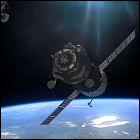 The twelfth full-time crew of the International Space Station lifts off from Russia’s Baikonur Cosmodrome aboard Soyuz TMA-7. Valery Tokarev and William McArthur take up residence on the ISS for 189 days. Arriving with them on the ISS for a nine-day stay is space tourist and entrepreneur Gregory Olsen, who personally funded his own trip aboard the Soyuz and returns to Earth aboard Soyuz TMA-6 with the Expedition 11 crew.
The twelfth full-time crew of the International Space Station lifts off from Russia’s Baikonur Cosmodrome aboard Soyuz TMA-7. Valery Tokarev and William McArthur take up residence on the ISS for 189 days. Arriving with them on the ISS for a nine-day stay is space tourist and entrepreneur Gregory Olsen, who personally funded his own trip aboard the Soyuz and returns to Earth aboard Soyuz TMA-6 with the Expedition 11 crew.
STS-114
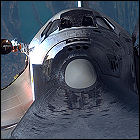 Space Shuttle Discovery lifts off on the first shuttle mission in over two years (and the first since the Columbia disaster) on a mission to resupply the International Space Station. Before docking at the station, Discovery performs the first Rendezvous Pitch Maneuver, a shuttle somersault devised by mission planners to allow the space station crew to extensively photograph the shuttle’s thermal tiles to identify areas of concern. As it turns out, some tile repairs are conducted on this mission before the shuttle can return home. Aboard Discovery for this flight are Commander Eileen Collins, Pilot James Kelly, and mission specialists Charles Camarda, Wendy Lawrence, Soichi Noguchi, Stephen Robinson and Andrew Thomas.
Space Shuttle Discovery lifts off on the first shuttle mission in over two years (and the first since the Columbia disaster) on a mission to resupply the International Space Station. Before docking at the station, Discovery performs the first Rendezvous Pitch Maneuver, a shuttle somersault devised by mission planners to allow the space station crew to extensively photograph the shuttle’s thermal tiles to identify areas of concern. As it turns out, some tile repairs are conducted on this mission before the shuttle can return home. Aboard Discovery for this flight are Commander Eileen Collins, Pilot James Kelly, and mission specialists Charles Camarda, Wendy Lawrence, Soichi Noguchi, Stephen Robinson and Andrew Thomas.
Apollo-Soyuz Crew Reunion
 The surviving Apollo-Soyuz Test Project astronauts and cosmonauts gather at the Stafford Air & Space Museum (founded by Apollo-Soyuz commander Thomas Stafford) in Weatherford, Oklahoma to mark the 30th anniversary of the first international manned spaceflight. (theLogBook.com’s webmaster is in attendance.)
The surviving Apollo-Soyuz Test Project astronauts and cosmonauts gather at the Stafford Air & Space Museum (founded by Apollo-Soyuz commander Thomas Stafford) in Weatherford, Oklahoma to mark the 30th anniversary of the first international manned spaceflight. (theLogBook.com’s webmaster is in attendance.)
Soyuz TMA-6 / ISS Expedition 11
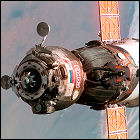 The eleventh full-time crew of the International Space Station lifts off from Russia’s Baikonur Cosmodrome aboard Soyuz TMA-6. Sergei Krikalev and John Phillips take up residence on the ISS for 179 days. Arriving with them on the ISS for a nine-day stay is astronaut Roberto Vittori, who returns to Earth aboard Soyuz TMA-5 with the Expedition 10 crew.
The eleventh full-time crew of the International Space Station lifts off from Russia’s Baikonur Cosmodrome aboard Soyuz TMA-6. Sergei Krikalev and John Phillips take up residence on the ISS for 179 days. Arriving with them on the ISS for a nine-day stay is astronaut Roberto Vittori, who returns to Earth aboard Soyuz TMA-5 with the Expedition 10 crew.
Expedition 10 makes a meal of the ISSues
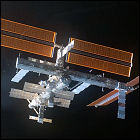 NASA orders the crew of the International Space Station to cut back on meals. Without the Space Shuttle delivering supplies to the station, resupply missions have been flown only by Russia’s much smaller unmanned Progress capsules, but the station was never designed to be restocked by Progress alone. Astronaut Leroy Chiao and cosmonaut Salizhan Sharipov are ordered to cut back on calories – with a reduction in workload to match – until more food arrives on a Progress capsule scheduled for liftoff on Christmas Eve. A failure of that flight could lead to an order to abandon the station.
NASA orders the crew of the International Space Station to cut back on meals. Without the Space Shuttle delivering supplies to the station, resupply missions have been flown only by Russia’s much smaller unmanned Progress capsules, but the station was never designed to be restocked by Progress alone. Astronaut Leroy Chiao and cosmonaut Salizhan Sharipov are ordered to cut back on calories – with a reduction in workload to match – until more food arrives on a Progress capsule scheduled for liftoff on Christmas Eve. A failure of that flight could lead to an order to abandon the station.
The longest-serving astronaut retires
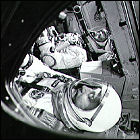 A veteran of the Gemini, Apollo and shuttle programs, 74-year-old astronaut John Young retires from NASA, capping off a 42-year career with the space agency. Young joined NASA in 1962 after hearing President Kennedy’s historic directive to launch a manned mission to the moon, and only three years later Young flew with Mercury veteran Gus Grissom on Gemini 3, the first manned two-person NASA mission. Young commanded Gemini 10 in 1966, was the command module pilot for the moon-orbiting Apollo 10 mission, and in 1972, Young commanded Apollo 16, landing in the moon’s mountainous Descartes region. Young commanded the first space shuttle mission, the maiden flight of Columbia in 1981, and commanded the ninth shuttle flight in 1983. Young had also served as the Chief Astronaut, determining crew assignments and making personnel decisions. In the wake of the Challenger disaster in 1986, Young became one of NASA’s most outspoken critics, and was reassigned to the position of special assistant for engineering, operations and safety – a move he regarded as a political one.
A veteran of the Gemini, Apollo and shuttle programs, 74-year-old astronaut John Young retires from NASA, capping off a 42-year career with the space agency. Young joined NASA in 1962 after hearing President Kennedy’s historic directive to launch a manned mission to the moon, and only three years later Young flew with Mercury veteran Gus Grissom on Gemini 3, the first manned two-person NASA mission. Young commanded Gemini 10 in 1966, was the command module pilot for the moon-orbiting Apollo 10 mission, and in 1972, Young commanded Apollo 16, landing in the moon’s mountainous Descartes region. Young commanded the first space shuttle mission, the maiden flight of Columbia in 1981, and commanded the ninth shuttle flight in 1983. Young had also served as the Chief Astronaut, determining crew assignments and making personnel decisions. In the wake of the Challenger disaster in 1986, Young became one of NASA’s most outspoken critics, and was reassigned to the position of special assistant for engineering, operations and safety – a move he regarded as a political one.
Soyuz TMA-5 / ISS Expedition 10
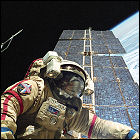 The tenth full-time crew of the International Space Station lifts off from Russia’s Baikonur Cosmodrome aboard Soyuz TMA-5. Salizhan Sharipov and Leroy Chiao take up residence on the ISS for 192 days. Arriving with them on the ISS for a nine-day stay is cosmonaut Yuri Shargin, who returns to Earth aboard Soyuz TMA-4 with the Expedition 9 crew.
The tenth full-time crew of the International Space Station lifts off from Russia’s Baikonur Cosmodrome aboard Soyuz TMA-5. Salizhan Sharipov and Leroy Chiao take up residence on the ISS for 192 days. Arriving with them on the ISS for a nine-day stay is cosmonaut Yuri Shargin, who returns to Earth aboard Soyuz TMA-4 with the Expedition 9 crew.
SpaceShip One wins the Ansari X Prize
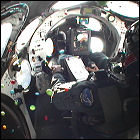 Privately-owned experimental space vehicle SpaceShip One makes its second qualifying flight into suborbital space, exceeding Mach 3 (the first privately owned vehicle to do so) and reaching an altitude of 112 kilometers. Brian Binnie pilots SpaceShip One for its third trip into space and earns the second set of FAA commercial astronaut wings as a result. A fourth trip is considered, but then cancelled to avoid any damage to the history-making vehicle. By this point, Virgin has already hired SpaceShip One designer Burt Rutan to build SpaceShip Two, a suborbtial passenger spacecraft which will take paying customers into space as part of the company’s “Virgin Galactic” service, based on the design of SpaceShip One. Rutan and investor (and Microsoft co-founder) Paul Allen also claim the $10,000,000 Ansari X Prize.
Privately-owned experimental space vehicle SpaceShip One makes its second qualifying flight into suborbital space, exceeding Mach 3 (the first privately owned vehicle to do so) and reaching an altitude of 112 kilometers. Brian Binnie pilots SpaceShip One for its third trip into space and earns the second set of FAA commercial astronaut wings as a result. A fourth trip is considered, but then cancelled to avoid any damage to the history-making vehicle. By this point, Virgin has already hired SpaceShip One designer Burt Rutan to build SpaceShip Two, a suborbtial passenger spacecraft which will take paying customers into space as part of the company’s “Virgin Galactic” service, based on the design of SpaceShip One. Rutan and investor (and Microsoft co-founder) Paul Allen also claim the $10,000,000 Ansari X Prize.
SpaceShip One twists into space
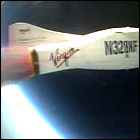 The first qualifying flight for the Ansari X Prize becomes a dangerous one for pilot Mike Melvill, as the experimental spacecraft SpaceShip One begins a rapid roll after its rocket engine ignites, sending the vehicle on a twisty trajectory into suborbital space. The vehicle reaches just under Mach 3, and still passes the altitude of 100 kilometers necessary to be considered a space flight (and to be considered a contender for the X Prize), but SpaceShip One must repeat the feat to win the $10,000,000 prize for launching the first privately funded spacecraft.
The first qualifying flight for the Ansari X Prize becomes a dangerous one for pilot Mike Melvill, as the experimental spacecraft SpaceShip One begins a rapid roll after its rocket engine ignites, sending the vehicle on a twisty trajectory into suborbital space. The vehicle reaches just under Mach 3, and still passes the altitude of 100 kilometers necessary to be considered a space flight (and to be considered a contender for the X Prize), but SpaceShip One must repeat the feat to win the $10,000,000 prize for launching the first privately funded spacecraft.
Private spaceflight test ends in explosion
![]() A team of Ansari X Prize hopefuls suffers a major setback when their vehicle, the Rubicon 1, explodes after liftoff in an unmanned test flight. According to Eric Meier, one of the designers of the Rubicon 1, the $20,000 vehicle cannot be recovered or repaired, but must be completely rebuilt. Meier and his team intend to build a new craft and continue vying for the X Prize, whose deadline is the end of 2004. Two other teams, one Canadian and one American, have already announced dates for their qualifying flights.
A team of Ansari X Prize hopefuls suffers a major setback when their vehicle, the Rubicon 1, explodes after liftoff in an unmanned test flight. According to Eric Meier, one of the designers of the Rubicon 1, the $20,000 vehicle cannot be recovered or repaired, but must be completely rebuilt. Meier and his team intend to build a new craft and continue vying for the X Prize, whose deadline is the end of 2004. Two other teams, one Canadian and one American, have already announced dates for their qualifying flights.
Risky spacewalk called off
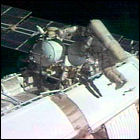 A risky spacewalk at the International Space Station is called off hurriedly, with astronaut Mike Fincke already through the open hatch. The oxygen container on Fincke’s spacesuit is the cause for concern, as mission controllers in Russia note that its pressure is rapidly dropping. Fincke and mission commander Gennady Padalka were en route to replace a circuit breaker, but due to a variety of other problems aboard the station they were exiting the station via the Russian-built airlock at the opposite end of the station from the breaker’s destination, requiring a 45-minute journey from one end of the station to the other. The spacewalk, rescheduled for a later date, will leave the station unoccupied with its entire crew outside for only the second time since the station became operational.
A risky spacewalk at the International Space Station is called off hurriedly, with astronaut Mike Fincke already through the open hatch. The oxygen container on Fincke’s spacesuit is the cause for concern, as mission controllers in Russia note that its pressure is rapidly dropping. Fincke and mission commander Gennady Padalka were en route to replace a circuit breaker, but due to a variety of other problems aboard the station they were exiting the station via the Russian-built airlock at the opposite end of the station from the breaker’s destination, requiring a 45-minute journey from one end of the station to the other. The spacewalk, rescheduled for a later date, will leave the station unoccupied with its entire crew outside for only the second time since the station became operational.
SpaceShip One: first private spaceflight
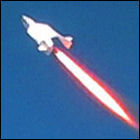 A joint venture between experimental aircraft designer Burt Rutan and investor/Microsoft co-founder Paul Allen, SpaceShip One becomes the first privately owned vehicle to cross the 100-kilometer boundary into space. It is one of several vehicles vying for the Ansari X Prize, a $10,000,000 competition to launch the first privately funded (in other words, not government-funded) space vehicle, even though this is considered one of its test flights and not a qualifying flight for the X Prize. Launched from an airplane “mothership” and dropped off seconds before its own rocket engine takes it into suborbital space, SpaceShip One nearly reaches Mach 3, and is already the first private aircraft to reach Mach 2. Pilot Mike Melvill becomes the first recipient of the Federal Aviation Administration’s commercial astronaut wings upon landing.
A joint venture between experimental aircraft designer Burt Rutan and investor/Microsoft co-founder Paul Allen, SpaceShip One becomes the first privately owned vehicle to cross the 100-kilometer boundary into space. It is one of several vehicles vying for the Ansari X Prize, a $10,000,000 competition to launch the first privately funded (in other words, not government-funded) space vehicle, even though this is considered one of its test flights and not a qualifying flight for the X Prize. Launched from an airplane “mothership” and dropped off seconds before its own rocket engine takes it into suborbital space, SpaceShip One nearly reaches Mach 3, and is already the first private aircraft to reach Mach 2. Pilot Mike Melvill becomes the first recipient of the Federal Aviation Administration’s commercial astronaut wings upon landing.